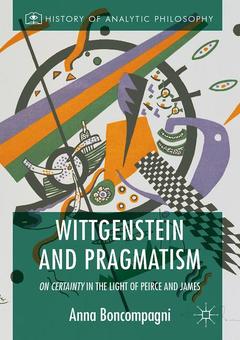Description
Wittgenstein and Pragmatism, 1st ed. 2016
On Certainty in the Light of Peirce and James
History of Analytic Philosophy Series
Language: English
Publication date: 12-2020
311 p. · 14.8x21 cm · Paperback
Publication date: 12-2016
Support: Print on demand
Description
/li>Contents
/li>Biography
/li>Comment
/li>
This book investigates the conflicts concerning pragmatism in
Wittgenstein?s work On Certainty, through a comparison with the
pragmatist tradition as expressed by its founding fathers Charles S. Peirce
and William James. It also describes Wittgenstein?s first encounters with
pragmatism in the 1930s and shows the relevance of Frank Ramsey in the
development of his thought. Offering a balanced, critical and theoreticalexamination the author discusses issues such as doubt, certainty, common
sense, forms of life, action and the pragmatic maxim. While highlighting
the objective convergences and divergences between the two approaches,
the volume makes links to ongoing debates on relativism, foundationalism,
scepticism and objectivity. It will be of interest to anyone searching for newperspectives on Wittgenstein?s philosophy.
Foreword
Acknowledgments
List of AbbreviationsIntroduction. ‘A kind of Weltanschauung’
Part I – Before On Certainty
Chapter 1. Pragmatism in Wittgenstein before On Certainty
1.1 Preliminary remarks
1.2 ‘Die pragmatistiche Auffassung von Wahr und Falsch’ 1.3 Wittgenstein and Ramsey1.4 Wittgenstein reader of James
1.5 Wittgenstein reader of Peirce?1.6 Other references to pragmatism before On Certainty
1.7 Concluding remarksPart II – On Certainty
Chapter 2. Reasonable doubts and unshakable certainties
2.1 Preliminary remarks
2.2 Doubt2.3 Skepticism and fallibilism
2.4 Wittgenstein’s ‘hinges’
2.5 Peirce’s ‘indubitables’ and ‘regulative assumptions’
2.6 Concluding remarks
Chapter 3. Common sense and Weltbild
3.1 Preliminary remarks
3.2 Peirce’s critical common sensism and James’ ‘mother-tongue of thought’
3.3 Wittgenstein’s Weltbild
3.4 Outlines for a comparison
3.5 Concluding remarks
Chapter 4. Action and the pragmatic maxim
4.1 Preliminary remarks
4.2 The pragmatic maxim
4.3 Perception and conduct, truth and belief
4.4 Meaning and consequences: the ‘Pragmatist Week’
4.5 Meaning and understanding
4.6 ‘Im Anfang war die Tat’
4.7 Action and its surroundings
4.8 Concluding remarksPart III – Broadening the Perspective
Chapter 5. From ground to background
5.1 Preliminary remarks
5.2 Forms of life in Wittgenstein’s writings5.3 Secondary literature: relativism and other issues
5.4 A human objectivity5.5 Background and foreground
5.6 Concluding remarksChapter 6. Between method and Weltanschauung
6.1 Preliminary remarks
6.2 ‘The good in pragmatism’6.3 Beyond method
6.4 Synoptic presentation and Weltanschauung
6.5 The river and the river-bed
6.6. Science and philosophy
6.7 Concluding remarks
Conclusion. ‘I’ll teach you differences’
Bibliography
Index
Anna Boncompagni (University of California, Irvine) works mainly on Wittgenstein’s later philosophy and on pragmatism, and is also interested in phenomenology, the history of analytic philosophy, and the philosophy of psychiatry. Her previous publications include “Elucidating Forms of Life: The Evolution of a Philosophical Tool”, Nordic Wittgenstein Review (2015) and Wittgenstein: Lo Sguardo e il Limite (2012).
Uncovers the alleged pragmatist side of Wittgenstein’s later philosophy
Explores doubt, certainty, common sense, forms of life, action and the pragmatic maxim
Describes the relevance of Frank Ramsey in the development of Wittgenstein’s thought




